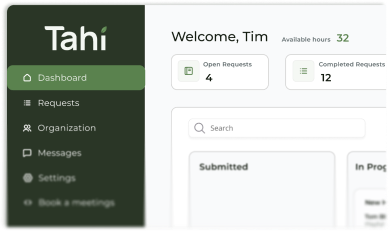Responsive Design
Responsive design ensures your website looks and works perfectly on any device, from a large desktop monitor to the smallest smartphone screen.
What is responsive design and why is it so important for modern websites?
Responsive design is an approach to web development that makes your website's pages render well on a variety of devices and screen sizes. Put simply, it means your website automatically adjusts its layout, images, and content to fit perfectly on any screen, whether it's a wide desktop monitor, a tablet, or a mobile phone. Gone are the days of needing a separate 'm.website.com' for mobile users. A single responsive site does it all.
This is crucial because your audience isn't just sitting at a desk anymore. They're browsing on their commute, researching on a tablet from the sofa, and making purchases on their phones. A website that isn't responsive forces users to pinch, zoom, and scroll endlessly, creating a frustrating experience. In today's digital world, a professional and seamless experience across all devices isn't just a nice-to-have, it's a fundamental requirement for a credible brand.
How does a responsive website improve user experience and conversions on mobile?
A responsive website dramatically improves the user experience (UX) by making it easy and intuitive for people to interact with your site on a smaller screen. Text is readable without zooming, buttons are easy to tap, and navigation is straightforward. This creates a smooth, frictionless journey for the visitor, which keeps them engaged and on your site for longer.
A positive user experience is directly linked to higher conversion rates. When a potential customer can easily find what they're looking for and complete an action, like filling out a form or making a purchase, they are far more likely to do so. A clunky, non-responsive site creates friction and frustration, causing users to abandon the site and turn to a competitor. With a significant portion of web traffic coming from mobile devices, optimising this experience is one of the most effective ways to boost your conversions.
Is my website being mobile-friendly a major ranking factor for Google?
Yes, absolutely. For several years now, Google has used 'mobile-first indexing'. This means Google predominantly uses the mobile version of your content for indexing and ranking. If your site provides a poor experience on mobile, your ability to rank in search results will be severely hampered, regardless of how great it looks on a desktop.
Furthermore, mobile-friendliness is a key component of overall page experience signals, which include the Core Web Vitals. These metrics measure how users perceive the experience of interacting with a web page, focusing on loading speed, interactivity, and visual stability. A non-responsive site almost always performs poorly on these mobile metrics. In short, if you want to be visible on Google, having a high-quality, responsive website is non-negotiable.
How does Webflow help build responsive websites better than other platforms?
Webflow is built from the ground up with responsive design at its core. Its visual canvas allows designers and developers to see exactly how a site will look and behave across different screen sizes, or 'breakpoints', in real-time. You can style elements for desktop, tablet, and mobile views independently, giving you precise control without needing to write complex media queries by hand.
Unlike many platforms that rely on pre-built themes or clunky page-builder plugins, Webflow's approach gives you complete creative freedom while producing clean, semantic HTML and CSS. This results in websites that are not only perfectly responsive but also lightweight and fast loading. This control and quality output is a major reason why we build exclusively on Webflow. It allows us to build truly custom, high-performing responsive experiences that other platforms struggle to match.
How do you ensure a Figma design becomes a perfectly responsive Webflow site?
The key to a successful responsive build is planning for it from the very beginning, right in the design phase. A static Figma file is just a picture of a website; turning it into a living, breathing, and fluid experience in Webflow requires a deep understanding of how design translates to development. It starts with a robust design system and a clear strategy for how layouts will adapt and reflow on smaller screens.
At Tahi Studio, our process is built around a seamless Figma to Webflow handoff. We don't just copy a design. We interpret it, ensuring every element, from typography to spacing, adapts gracefully across all breakpoints. We build with scalability and performance in mind, ensuring the final product is not only pixel-perfect but also fast and fully optimised for every device.
If you have a design you're proud of and need an expert partner to bring it to life as a high-performing responsive website, we're here to help. You can get in touch with us to discuss your project or book a free site audit to see how we can improve your current website's performance.







